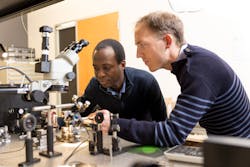'Bound states in the continuum' photonic cavity is more-efficient way to trap light
Engineers at the University of California, San Diego have demonstrated a new and more efficient way to trap light, using a phenomenon called bound states in the continuum (BIC), in which interference in open photonic systems in a continuum lead to bound electromagnetic states.1
Boubacar Kanté, an assistant professor in electrical and computer engineering at UC San Diego, and his postdoctoral researcher Thomas Lepetit sought a better way to boost the quality factor Q in small photonic cavities. They designed a metamaterial BIC device consisting of a rectangular metal waveguide and ceramic light scatterer. Instead of limiting cavity losses the usual way by reducing the size and number of passages where light can escape, the cavity’s design produces destructive interferences that, when light is allowed to escape,the multiple waves that do so through different passages end up canceling each other.
“The goal in the future is to make a computer that performs all kinds of operations using light, not electronics, because electronic circuits are relatively slow. We expect that an optical computer would be faster by three to four orders of magnitude.” Kanté said. “But to do this, we have to be able to stop light and store it in some kind of cavity for an extensive amount of time.”
They coupled all-dielectric deep-subwavelength resonators together and observed multiple BIC states. In contrast, earlier researchers had reported observing only one BIC within their systems. Lepetit and Kanté observed multiple bound states in their system, which make the light trap more robust and less vulnerable to outside disruptions.
The technique could be used to enhance certain nonlinear interactions between light and matter, useful in biosensors and compact photovoltaic cells.
Source: http://www.jacobsschool.ucsd.edu/news/news_releases/release.sfe?id=1678
REFERENCE:
1. Thomas Lepetit and Boubacar Kanté, Physical Review B (2014); doi: 10.1103/PhysRevB.90.241103

John Wallace | Senior Technical Editor (1998-2022)
John Wallace was with Laser Focus World for nearly 25 years, retiring in late June 2022. He obtained a bachelor's degree in mechanical engineering and physics at Rutgers University and a master's in optical engineering at the University of Rochester. Before becoming an editor, John worked as an engineer at RCA, Exxon, Eastman Kodak, and GCA Corporation.
